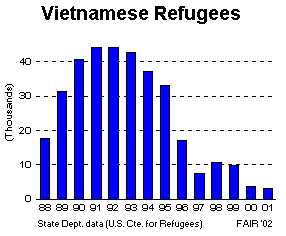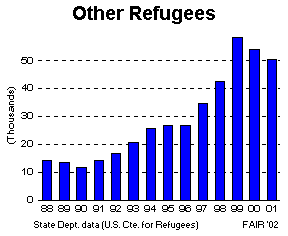Refugees and Asylees

August 2003
To qualify as a refugee, a person must meet the following definition from Section 101(a)(42) of the Immigration and Nationality Act:
any person who… is unable or unwilling to return to, and is unable or unwilling to avail himself or herself of the protection of that country because of persecution or a well-founded fear of persecution on account of race, religion, nationality, membership in a particular social group, or political opinion….
| Refugee and Asylum Admissions — 1980 to 2000 | |
| Vietnam | 561,507 |
| USSR/FSU | 386,960 |
| Cuba | 263,229 |
| Laos | 196,601 |
| Cambodia | 124,841 |
| Iran | 75,823 |
| Thailand | 53,823 |
| Romania | 45,911 |
| Poland | 44,185 |
| Haiti | 39,393 |
| Nicaragua | 36,420 |
| Ethiopia | 33,539 |
| Bosnia | 31,934 |
| Iraq | 28,522 |
| P.R.China | 16,069 |
| Other | 222,711 |
| Total | 2,161,468 |
The distinction between refugees and asylees is that refugees apply for entry to the U.S. from abroad, and asylees are already in the U.S., legally or illegally, when the application is made.
The Refugee Act of 1980 set up a system of consultation between the executive branch (State Department) and the legislative branch to establish the annual number of refugees to be admitted for permanent residence. That ceiling is not on the arrival in the U.S. of new refugees, although it sets the framework for that process, but rather the adjustment to permanent residence for refugees and asylees who have already been in the country for at least a year.
The 1980 Act contemplated a program for the admission of 50,000 refugees per year. However, the lowest number of adjustments since then was 84,288 in FY’98. The number has consistently been well in excess of 100,000 since FY’91, and the average FY’80 to FY’96 has been above 110,000. The agreed admission levels for FY’96 and FY’97, however, have registered a decline. In 1997 the authorization was for 90,000 and in 1998 it was for 78,000. Lower refugee adjustment data will not show up until the FY’97 and FY’98 statistics.
The pattern of refugee entry has varied among countries. Most of Haiti’s total number of entrants occurred in one year, FY’88. Before and since then the flow has been largely a trickle, although the refugee admissions have been rising again since FY’94. The flow from Romania and Poland was steep until FY’93, and has dropped off. By contrast, the refugee flow from the former Soviet Union took a major jump in 1990 as a result of the Lautenberg Amendment, but has subsided.
Why Have Refugee Admissions Fallen?
“Decisions about refugee status…in the United States are shaped by a variety of sources: foreign governments, the media, political pressure groups, and the people who claim to be refugees. Considerations have gone well beyond the simple desire of the American people to assist those who are truly persecuted.”
-Eugene McCarthy, A Colony of the World.
“This country has focused on resettlement … to the point that we have not spent a great deal of time on the use of diplomatic, military, and economic mechanisms to prevent refugee flows to begin with and to bring about the conditions that would allow people to be repatriated.”
-Prof. Charles Keeley, Georgetown University.
At a Senate hearing of the Immigration Subcommittee on February 12, 2002, ranking minority member Sen. Sam Brownback (R-KS) asked, “Why has the number of refugees declined over the past ten years? Do we need to change the law so that we can reach the cap every year?” (The data from the Department of State, compiled by the U.S. Committee for Refugees, that demonstrate this trend are depicted below.)
In response to that question, Arthur Dewey, Asst. Secretary of State for Population, Refugees, and Migration Affairs, noted that during the 1980’s, our refugee program was overwhelmingly focused on refugees from Vietnam, and during the early 1990’s, religious minorities from the newly independent states of the former Soviet Union became the dominant group.
| 2001 Top 10 Donor Countries to International Refugee Aid Agencies | |
| United States | $387.1 million |
| Japan | $121.8 million |
| European Union | $83.1 million |
| Germany | $64.2 million |
| Sweden | $64 million |
| United Kingdom | $62.8 million |
| Netherlands | $60.9 million |
| Norway | $56.5 million |
| Denmark | $49.6 million |
| Switzerland | $41.2 million |
Mr. Dewey might also have explained to Sen. Brownback that refugee resettlement in the United States has been rising since the 1980’s for people from countries other than the earlier major source countries. The decline of the refugee flow from these countries was not due to a restriction in the refugee program, but rather was because the conditions that had generated the refugee flows had abated or disappeared.
Additionally, a large part of the earlier refugee flow came from programs that were not admitting true refugees as recognized by the U.N. High Commissioner for Refugees. These programs included the program for Jews and other religious minorities from the Soviet Union, Amerasian children, Cubans, and Chinese applying for asylum.
The large refugee flows generate by our involvement in the Cold War and the Vietnam War and the break-up of the Soviet Union and Yugoslavia have now dwindled. Refugee flows are much reduced from Cambodia, Laos and Vietnam as well as from Poland, Romania and the Soviet Union. To demonstrate this, the refugee flows from the former Soviet Union and Vietnam are shown below.
When these Cold War related immigration flows are subtracted from the overall flow, the results show a very different trend, as also depicted below. Refugee intake has been increasing steadily from other areas. The peak year of FY’99 was not representative of the trend, because it was augmented by a non-recurring flow of over 14,000 refugees from Kosovo. In the next year, refugees from the former Yugoslavia, including Kosovo, dropped to 520 refugees.



Refugee Resettlement Problem Areas
When the Refugee Act was adopted in 1980, authorization was given for a resettlement assistance program to last for three years. During that period, the agencies that manage the reception and settlement of new refugees would have funds for necessities—clothing, housing, food—as well as English language instruction and job training. Appropriation of the funds necessary to support this program was a different matter. As the number of refugees rose, the funding per refugee declined, falling eventually to only enough for about eight months of support services.
Refugees were not abandoned to sink or swim at the end of that period, though, because food stamps, assisted housing, child welfare, and other programs were available. Unsurprisingly, the Department of Health and Human Services, which houses the Office of Refugee Programs, found that many refugees became long-term welfare users rather than self-supporting.
The nationality and cultural background of the refugees tended to vary widely in studies of the transition of refugees into American life. Rural people with little if any schooling, such as the Hmong, have encountered a greater problem in becoming self-supporting than Eastern Europeans. Presumably similar assimilative problems will be encountered with Kurds, who have recently been admitted as asylees (bypassing the refugee screening process by taking them to Guam for asylum protection in the United States).
Another problem area is the admission of elderly refugees who are likely to be dependent on the American taxpayer for support for the rest of their lives. In part, this problem of elderly refugees is a result of organizing the refugee admissions criteria into a microcosm of the family preference system for regular immigration. A person who is a bona fide refugee, in the sense that she or he fears persecution if returned home, may sponsor other family members, including not just immediate family members, but also parents and siblings. Unlike other immigrants, they are not required to wait until they become U.S. citizens.
Reform Options
The Commission on Immigration Reform recommended that refugee admissions be scaled back to the 50,000 level contemplated in the 1980 Act (although unlike the 1980 Act, asylum adjustments would be on top of that limit, rather than part of it). That idea was incorporated in the 1996 reform effort but was deleted along with other non-illegal alien measures.
A reform of the refugee system, in addition to reducing the overall admissions level, might require that applicants—other than immediate family members—qualify in their own right. They could still enter as immigrants or refugees if they met the requirements of the law.
They would no longer be entitled to derivative status on the basis of the admission of an earlier refugee. This would significantly reduce the admission of persons likely to become permanent public charges. Similarly, among refugees who are not in imminent danger, priority could be specified for admission of those who have the greatest likelihood of being self-supporting after arrival.
